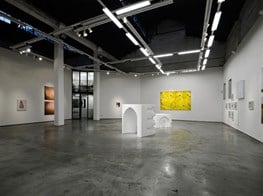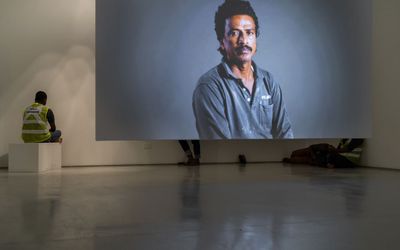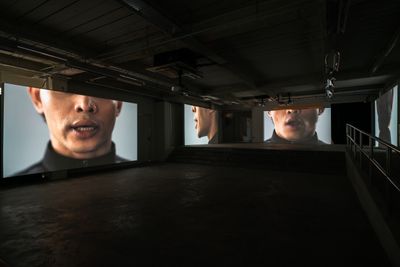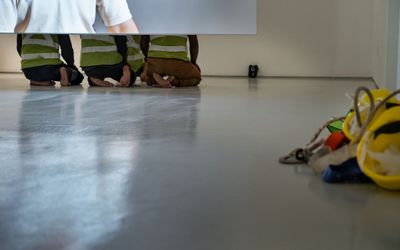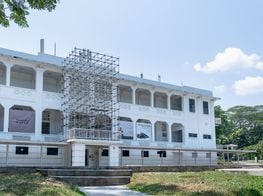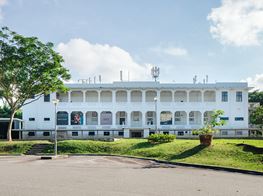Arin Rungjang Connects Diasporic Narratives at ShanghART, Singapore
Arin Rungjang was born in Bangkok in 1975, a time of political turmoil in Thailand. Two years prior, student demonstrations led to the fall of military dictator Thanom Kittikachorn, who returned from exile in 1976. That year, students gathered at Thammasat University to protest and the military opened fire; 46 died, 167 were wounded, and over 3,000 arrested. In 1977, Rungjang's father, an engineer working for a German shipping company, died of cancer and internal injuries sustained when a group of Neo-Nazis assaulted him in Hamburg. Rungjang reached adulthood in the midst of continuing social instability in Thailand; he graduated with a BFA in Graphic Arts from Silpakorn University in 2002.

Arin Rungjang, Prayong (Aglaia odorata): Dedicated to my Father (Southeast Asia Edition) (2019). Video installation; single-channel video. 24 min. Exhibition view: They Beat Your Father 他们殴打你的父亲, ShanghART, Singapore (4 August–30 November 2019). Courtesy ShanghART.
Much of Rungjang's practice remains connected to his past, intersecting personal and collective memories, often in the form of interviews with marginalised or diasporic communities. In his videos and installations, stories of displacement and discrimination shed light on inextricable temporal relationships. In the case of the artist's solo exhibition at ShanghART Singapore, They Beat Your Father (4 August–30 November 2019), Prayong (Aglaia odorata): Dedicated to my Father (Southeast Asia Edition) (2019) is named after his father, Prayong.
Prayong (Aglaia odorata) comes in two parts—a steel scaffold installation on the balcony outside the ShanghArt building, where performances are scheduled for the duration of the show, and a single-channel video in the main gallery. The 24-minute silent film contains portraits of migrant workers currently living in Singapore, and is accompanied by hard copies of text from Rungjang's conversations with them about their lives and aspirations for the future. A man named Shohel Rana, for example, fled with his family from Pakistan to Bangladesh during the Bangladesh Liberation War and hopes to settle in their new home.
This desire for Rana to settle relates to the other name in the work's title. Aglaia odorata is a small evergreen tree originally native to East and Southeast Asian countries, but widely found in other continents today; a history that brings to mind the uprooting and rooting of organic bodies.
Another work on view in Singapore is Shooting an Elephant and the Leader (2018), a video installation consisting of ten screens that debuted at last year's Shanghai Biennale (Proregress, 10 November 2019–10 March 2019). Its title derives from George Orwell's 1936 essay Shooting an Elephant, in which the English writer recounts an incident during his service as a police officer in Burma (now Myanmar). Resented by anti-European locals, he was compelled to shoot a hostile elephant despite his reluctance to satisfy them. While the story may not be authentic, it has been interpreted as a metaphor for the detrimental impact of imperialism on not only the colonised but also the coloniser.
Shooting an Elephant and the Leader and Prayong (Aglaia odorata) are continuations of Rungjang's previous projects that interrogate individual histories and migrant flows, especially between Thailand and its neighbouring countries. Unequal Exchange, No Exchange Can be Unequal (2011), exhibited at the Singapore Biennale (13 March–15 May 2011), for example, is a video compiling Rungjang's interviews with Thai migrant workers at the Golden Mile Complex, a Thai equivalent of a Chinatown in Singapore, and the people still living in their home villages in Thailand.
In addition to screening the video at the Biennale, Rungjang invited the workers to trade their old furniture with new IKEA furniture on site free of charge. Deriving its title from 'Unequal Exchange', an economic term coined in 1962 by Marxist economist Arghiri Emmanuel to describe the unequal exchange between developing and developed countries, Rungjang's work followed Thai migration to Singapore, which has been ongoing since the 1990s, and the lives of labourers from the outside.
The emphasis on the individual in Rungjang's work means to create alternatives to the glorified tales of capitalist success, including the official histories that so often undermine lived experience. The works presented at They Beat Your Father are precisely such alternatives: re-examinations of the conditions that people not only live with, but actually remember.—[O]

